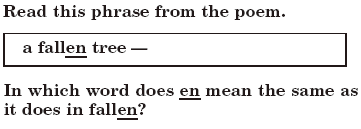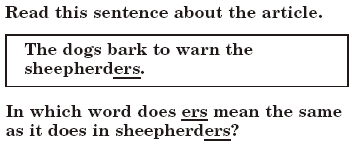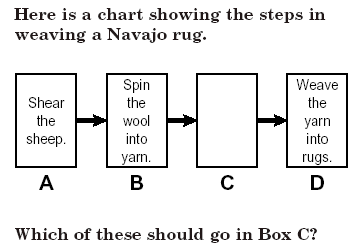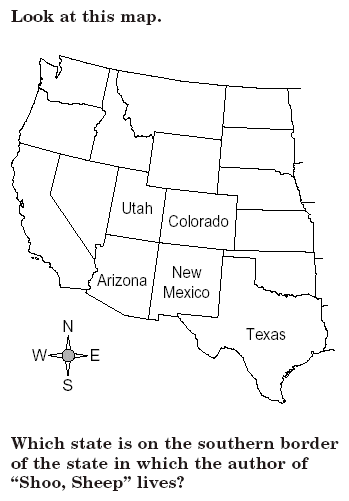Grade 5: Reading/Literature & Research (2000 VDOE Released Items)
Multiple-Choice Exercise
Content © 2000 Commonwealth of Virginia Department of Education; Permission to Use Granted by VDOE; Author of Activity: Tami Maloney; All rights reserved.
No commercial, for-profit use of this material is allowed. E-mail comments and questions to Tami Maloney.
Choose the correct answer for each question.


As it is used in line 2 of this poem, the word crook means --
- thief
- curve
- tool
- cane
-

-

-

-



This poem suggests that --
- the work that grownups do is more important than anything else
- children should let go of their troubles and have more fun
- people should pay more attention to the beautiful things around them
- spiders are dangerous creatures that should be avoided


The author wrote lines 1 through 4 mostly to help the reader --
- be entertained by a lively rhythm
- understand how thoughtless people can be
- picture the setting and subject of the poem
- learn how a spider spins a web


Lines 17 through 20 will most likely make the reader feel --
- quiet and peaceful
- angry at the children
- excited and full of fun
- worried about the web


Phrases such as "lit with dew" in line 6 and "so delicate" in line 7 give the reader a sense of the --
- size of the spider
- importance of art
- beauty of the web
- innocence of children


Words such as "screeching," "heavy," "ran," and "kicked" give the reader a sense of --
- loneliness
- danger
- silliness
- hope


How did the children feel at the end of the poem?
- Sad
- Amused
- Furious
- Relieved


The children in the poem can best be described as --
- caring
- cruel
- clever
- charming
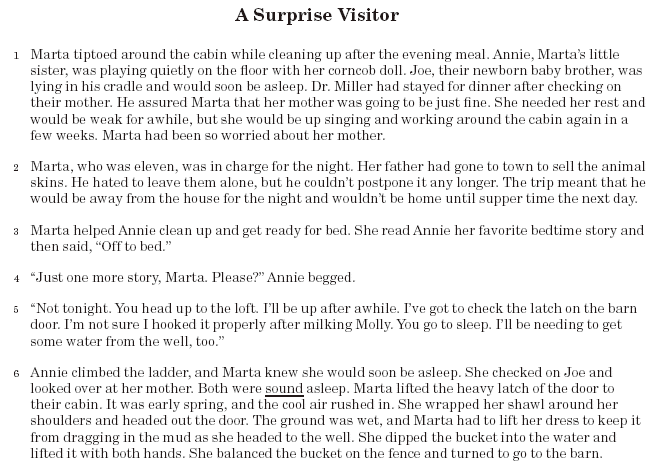
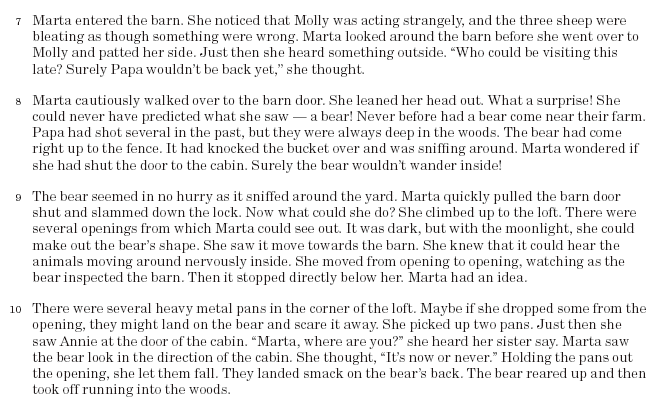

As it is used in paragraph 6, the word sound means --
- noise
- deep
- healthy
- wise



Which question might paragraph 5 answer?
- Why did Marta go outside?
- How many animals were in the barn?
- When did Annie milk the cow?
- Was the weather warm or cold?



Which question does paragraph 8 answer?
- Why was Marta's mother sick?
- How did Marta scare the bear away?
- Why did Papa leave the family alone for the night?
- What frightened Marta while she was in the barn?



Marta can best be described as --
- easily frightened
- too curious
- always cheerful
- brave and responsible



This story is mainly about how a young girl --
- welcomes her father back home
- acts in a dangerous situation
- takes good care of her baby brother
- nurses her sick mother back to health



Marta suddenly dropped the pans on the bear because she --
- accidentally let them fall
- saw the bear going into the barn
- wanted to protect her sister
- thought it would be funny



All of these add to the suspense in the passage except which one?
- Annie asks for one more bedtime story.
- Marta's father is gone for the night.
- There is a bear near the cabin.
- Marta's mother is weak and has a new baby.



Which detail tells you that this passage may be historical fiction?
- There is a new baby in the house.
- The event happens in early spring.
- The family lives far from town.
- Annie has a corncob doll.
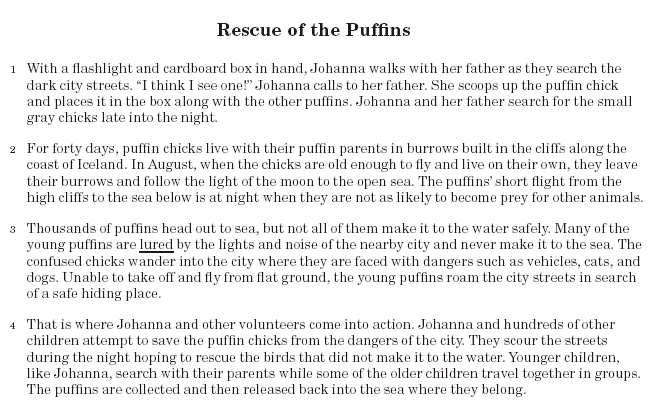
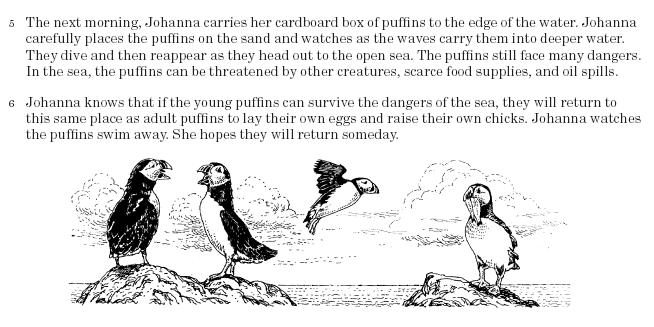
As it is used in paragraph 3, the word lured means --
- guided
- satisfied
- drowned
- attracted


Which question does paragraph 3 answer?
- How do the puffins live while they are out at sea?
- At what time of year do puffins head out to sea?
- Why do some baby puffins become lost in the city?
- What will Johanna do with the chicks that she finds?


The volunteers work together to --
- find lost puffin chicks and take them to the sea
- rescue puffin chicks and keep them as pets
- put puffin chicks back into their burrows
- reunite puffin chicks with their parents


Which paragraph could best have the heading "Leaving the Burrow"?
- 1
- 2
- 4
- 5


Which information from the passage best supports the idea that puffins live in burrows only while raising their young?
- Thousands of puffins head out to sea, but not all of them make it to the water safely.
- In the city, the young puffins face dangers such as vehicles, cats, and dogs.
- Younger children, like Johanna, search with their parents while some of the older children travel together in groups.
- Johanna watches the chicks swim out to the open sea and hopes that they will return as adults to lay their eggs.


The author makes this passage both entertain and inform the reader by--
- telling a funny joke at the end
- asking readers to help animals whenever they can
- giving facts to readers in the form of an interesting story
- telling a nice story about a group of friends


The author included paragraphs 2 and 3 to --
- help the reader understand what is going on in the rest of the story
- explain why many puffins can't fly
- make the reader want to visit the country of Iceland in the future
- introduce the story's main character


After reading the first paragraph, the reader will most likely --
- know what an adult puffin looks like
- wonder what Johanna and her father are doing
- understand how baby puffin chicks can be raised by people
- find out which country the story happens in


How does Johanna feel at the end of the passage?
- Tired but curious
- Happy and amused
- Worried and hopeful
- Angry and sad
-

-

-

-


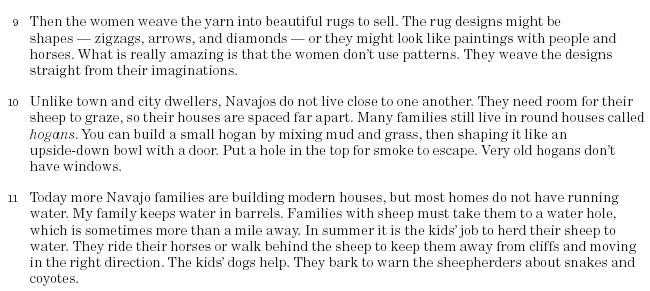
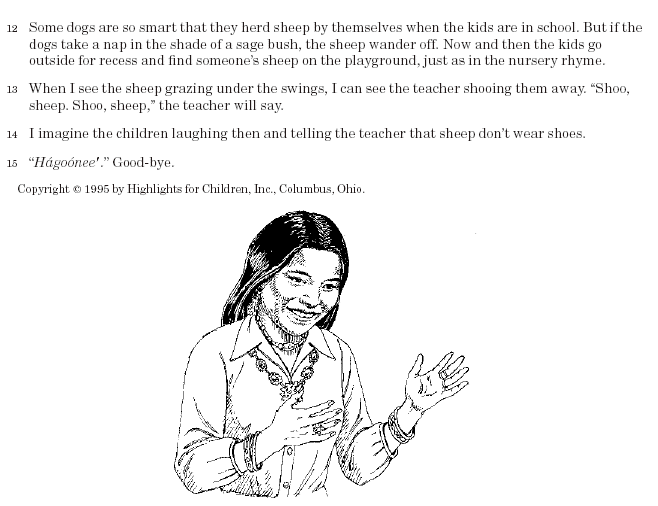
You can tell from information presented in this article that --
- all Navajo people have running water in their homes today
- Navajo pupils are punished if their sheep graze on the playground
- only one of the states has a Navajo reservation location in it
- snakes and coyotes are a dangerous threat to sheep



Sometimes sheep graze on the school playground because --
- the sheepherding dogs fall asleep on the job
- the children like to play with them at recess
- the children are supposed to watch them
- it is important to learn about sheep at school



If you were asked to skim this article, you should read --
- every word of the article silently but carefully
- only the first and last paragraphs of the article
- quickly through the article to see what the important points are
- the title and write what you think it will be about
- Paint a picture to weave into a rug later.
- Color the yarn with plant dyes.
- Trim the sheep's coat of wool quite short.
- Sell the beautiful woven rugs.
- Utah
- Texas
- Colorado
- Arizona



Why does the author tell a nursery rhyme near the beginning of the article?
- It is one of the author's favorite nursery rhymes from her childhood.
- Nursery rhymes are used as an important teaching tool in Navajo schools.
- It describes a scene that sometimes happens on Navajo reservations.
- The nursery rhyme was originally written in the Navajo language.
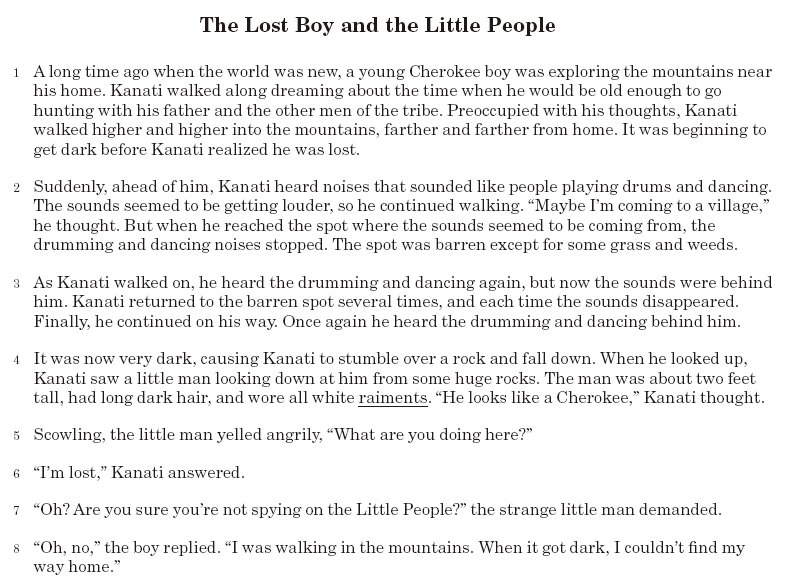

In paragraph 4, the word raiments means --
- whiskers
- sunlight
- hair
- clothing


Which question is not answered in paragraph 4?
- Why did the little man yell at Kanati?
- What did the little man look like?
- Why did Kanati stumble and fall down?
- When did Kanati first see the little man?


If the author added a sentence at the end of the first paragraph, which of these would fit best?
- This story happened a very, very long time ago.
- Kanati paused, wondering what he should do next.
- Many Cherokee tales take place in the mountains.
- Kanati hoped that a little man would come to help him.


To find more stories like this one, you should look in --
- a book of animal tales from around the world
- an encyclopedia under "Cherokee"
- an anthology of Native American stories
- a textbook about American history


Why did the little man become angry at Kanati?
- He was too tired to help Kanati find his way home.
- Kanati fell on the little man and hurt him.
- He thought Kanati was watching the Little People.
- Kanati was making too much noise with his drum.


If you wanted to find the part of the story where another person joins the boy, you could --
- skim until you reach a conversation
- go directly to the end of the story
- skim until you find the name of a place
- study the first paragraph carefully


The purpose of this story is to --
- teach a lesson in an entertaining way
- give directions to a special place
- provide facts about the Cherokee people
- tell a funny story about a silly boy


Which sentence describes how Kanati probably felt about the little man at the end of the story?
- Kanati was amused by the strange and funny little man.
- Kanati respected the little man and was grateful for his help.
- Kanati was afraid of the angry little man and what he might do.
- Kanati felt sorry for the little man and wanted to help him.


The little man led Kanati home, and in exchange Kanati had to --
- become a spy
- drum and dance
- give a gift
- keep a secret




